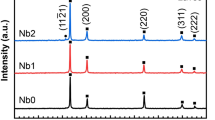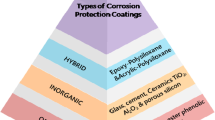Abstract
Grain boundary engineering (GBE) of coatings using optimum weight fractions of foreign inclusions can improve corrosion resistance performance. This is illustrated here by correlating the corrosion behavior with the five-parameter grain boundary character distribution analysis of Zn-carbon nanotube (Zn-CNT) composite coatings. Zn-CNT composite coatings with different volume fractions of CNTs were electrodeposited on mild steel substrates by dispersing different amounts of CNTs (4, 6, 8, 10, 15, and 20 mg/L) in the Zn electrolyte bath. All the coatings exhibited compact and crack-free morphology. Electrochemical impedance spectroscopy (EIS) measurements were conducted in 3.5 wt pct NaCl solution. The Nyquist and Bode plots showed a decrease in the coating corrosion rate with initial CNT addition up to the Zn-CNT3 coating (produced from 8 mg/L of CNT in the electrolyte), after which the corrosion resistance decreased with continued addition of CNTs. This showed that an optimum exists for CNT in the Zn coating to achieve high corrosion resistance performance. Orientation distribution maps from the coating cross section were acquired using the electron backscatter diffraction (EBSD) technique for correlating the microstructure with the corrosion data. The lower corrosion rate in the Zn-CNT3 coating was attributed to the strong basal plane texture in grains along the growth direction. The angle/axis misorientation showed that most grain boundaries have [\( 2\overline{11} 0 \)] and [\( 10\bar{1}0 \)] axis misorientations signifying special grain boundaries. The five-parameter analysis showed that these grain boundaries are mostly symmetric and tilt boundaries, which are low-energy boundaries, whereas in Zn and Zn-CNT6 (produced from 20 mg/L of CNT in the electrolyte) coatings, the higher corrosion rates were due to the high fraction of high-angle grain boundaries (HAGBs), grain texture along the growth direction that corresponds to an orientation that is active in the corrosive environment, and the absence of special grain boundaries.
















Similar content being viewed by others
References
V. Randle, G.S. Rohrer, H.M. Miller, M. Coleman, and G.T. Owen: Acta Mater., 2008, vol. 56, pp. 2363–73.
S. Yang, Z.J. Wang, H. Kokawa, and Y.S. Sato: J. Mater. Sci., 2007, vol. 42, pp. 847–53.
C.M. Barr, A.C. Leff, R.W. Demott, R.D. Doherty, and M.L. Taheri: Acta Mater., 2018, vol. 144, pp. 281–91.
C.S. Kim, Y. Hu, G.S. Rohrer, and V. Randle: Scr. Mater., 2005, vol. 52, pp. 633–7.
M. Coleman and V. Randle: Metall. Mater. Trans. A Phys. Metall. Mater. Sci., 2008, vol. 39, pp. 2175–83.
A. Ma, S. Jiang, Y. Zheng, Z. Yao, W. Ke, and S. Xia: Acta Metall. Sin. (English Lett.), 2014, vol. 27, pp. 730–38.
S. Xia, H. Li, T.G. Liu, and B.X. Zhou: J. Nucl. Mater., 2011, vol. 416, pp. 303–10.
M. Kumar, A.J. Schwartz, and W.E. King: Acta Mater., 2002, vol. 50, pp. 2599–612.
V. Randle: Acta Mater., 1999, vol. 47, pp. 4187–96.
V. Randle, G.S. Rohrer, and Y. Hu: Scr. Mater., 2008, vol. 58, pp. 183–6.
H. Beladi, Q. Chao, and G.S. Rohrer: Acta Mater., 2014, vol. 80, pp. 478–89.
H. Beladi, A. Ghaderi, and G.S. Rohrer: Philos. Mag., 2020, vol. 100, pp. 456–66.
M.N. Kelly, K. Glowinski, N.T. Nuhfer, and G.S. Rohrer: Acta Mater., 2016, vol. 111, pp. 22–30.
I. Ghamarian, P. Samimi, G.S. Rohrer, and P.C. Collins: Acta Mater., 2017, vol. 130, pp. 164–76.
F. Ram, J.T. Lloyd, and G.S. Rohrer: Mater. Charact., https://doi.org/10.1016/j.matchar.2019.110014.
Y. Toshev, V. Mandova, N. Boshkov, D. Stoychev, P. Petrov, N. Tsvetkova, G. Raichevski, C. Tsvetanov, A. Gabev, R. Velev, and K. Kostadinov: Protective Coating of Zinc and Zinc Alloys for Industrial Applications, Woodhead Publishing Limited, 2006.
G.D. Wilcox and D.R. Gabe: Corros. Sci., 1993, vol. 35, pp. 1251–8.
C. Cachet, R. Wiart, and J. Zoppas-Ferreira: Electrochim. Acta, 1993, vol. 38, pp. 311–8.
C. Cachet and R. Wiart: J. Electroanal. Chem., 1981, vol. 129, pp. 103–14.
D. Giménez-Romero, J.J. García-Jareño, and F. Vicente: J. Electroanal. Chem., 2004, vol. 572, pp. 235–47.
C. Cachet and R. Wiart: Electrochim. Acta, 1999, vol. 44, pp. 4743–51.
M. Ohba, T. Scarazzato, D.C.R. Espinosa, and Z. Panossian: Electrochim. Acta, 2019, vol. 309, pp. 86–103.
P.I. Nemes, M. Lekka, L. Fedrizzi, and L.M. Muresan: Surf. Coatings Technol., 2014, vol. 252, pp. 102–7.
B.M. Praveen, T.V. Venkatesha, Y.A. Naik, and K. Prashantha: Synth. React. Inorg. Met. Nano Met. Chem., 2007, vol. 37, pp. 461–65.
S. Hashimoto, M. Abe: Corros. Sci., 1994, vol. 36, pp. 2125–37
G. Roventi, T. Bellezze, and R. Fratesi: J. Appl. Electrochem., 2013, vol. 43, pp. 839–46.
A. Gupta and C. Srivastava: Metall. Mater. Trans. A Phys. Metall. Mater. Sci., 2020, vol. 51, pp. 4257–73.
S. Arora, N. Kumari, and C. Srivastava: J. Alloys Compd., 2019, vol. 801, pp. 449–59.
M.K. Punith Kumar, M.P. Singh, and C. Srivastava: RSC Adv., 2015, vol. 5, pp. 25603–08.
R. Li, J. Liang, Y. Hou, and Q. Chu: RSC Adv., 2015, vol. 5, pp. 60698–707.
R. M Y and C. Srivastava: Corros. Sci., 2019, vol. 152, pp. 234–48.
B.M. Praveen, T. V. Venkatesha, Y. Arthoba Naik, and K. Prashantha: Surf. Coat. Technol., 2007, vol. 201, pp. 5836–42.
K. Deepak, S. Mandal, C.N. Athreya, D.I. Kim, B. de Boer, and V. Subramanya Sarma: Corros. Sci., 2016, vol. 106, pp. 293–97.
A. Telang, A.S. Gill, M. Kumar, S. Teysseyre, D. Qian, S.R. Mannava, and V.K. Vasudevan: Acta Mater., 2016, vol. 113, pp. 180–93.
D. An, T.A. Griffiths, P. Konijnenberg, S. Mandal, Z. Wang, and S. Zaefferer: Acta Mater., 2018, vol. 156, pp. 297–309.
K.S. Jyotheender, A. Gupta, and C. Srivastava: Materialia, 2020, vol. 9, p. 100617.
K. Morshed-Behbahani, P. Najafisayar, M. Pakshir, and M. Shahsavari: Corros. Sci., 2018, vol. 138, pp. 28–41.
K.S. Jyotheender and C. Srivastava: Compos. Part B Eng., 2019, vol. 175, p. 107145.
V. Ezhilselvi, H. Seenivasan, P. Bera, and C. Anandan: RSC Adv., 2014, vol. 4, pp. 46293–304.
Y. Meng, L. Liu, D. Zhang, C. Dong, Y. Yan, A.A. Volinsky, and L.N. Wang: Bioact. Mater., 2019, vol. 4, pp. 87–96.
A. Maciej, A. Wadas, M. Sowa, R. Socha, G. Dercz, M. Rabe, and W. Simka: Corros. Sci., 2019, vol. 158, p. 108107.
M.K. Punith Kumar and C. Srivastava: Mater. Charact., 2013, vol. 85, pp. 82–91.
K.E. García, A.L. Morales, C.A. Barrero, and J.M. Greneche: Corros. Sci., 2006, vol. 48, pp. 2813–30.
ASTM Standard G31-72: Standard Practice for Laboratory Immersion Corrosion Testing of Metals, ASTM standards, West Conshohocken, 2004.
J. Wang and I.J. Beyerlein: Model. Simul. Mater. Sci. Eng., 2012, vol. 20, pp. 0–22.
J. Wang and I.J. Beyerlein: Metall. Mater. Trans. A Phys. Metall. Mater. Sci., 2012, vol. 43, pp. 3556–69.
Acknowledgments
The authors acknowledge the research funding received from the CSIR, Government of India. Electron microscopy facilities in AFMM, IISc Bangalore, are also acknowledged.
Author information
Authors and Affiliations
Corresponding author
Additional information
Publisher's Note
Springer Nature remains neutral with regard to jurisdictional claims in published maps and institutional affiliations.
Manuscript submitted June 29, 2020, accepted October 14, 2020.
Rights and permissions
About this article
Cite this article
Jyotheender, K.S., Srivastava, C. Correlating the Five-Parameter Grain Boundary Character Distribution and Corrosion Behavior of Zinc-Carbon Nanotube Composite Coatings. Metall Mater Trans A 52, 364–377 (2021). https://doi.org/10.1007/s11661-020-06070-y
Received:
Accepted:
Published:
Issue Date:
DOI: https://doi.org/10.1007/s11661-020-06070-y




